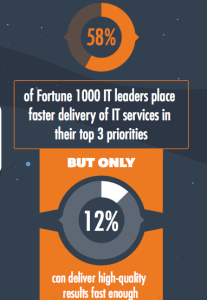Companies Must Get Addicted to Moving Fast
This blog series is about technology and business speed – how it’s stressing organizations; why they need to catch up; and how they can make up lost ground – before they get left behind. The first post, which follows, lays out the problem and solution.
The commercial world is under siege today, thanks to the hyper-speed that’s necessary to meet 24×7 demand from digitally empowered customers everywhere.
Customers now expect on-demand service, putting serious pressure on business leaders to execute faster. At the same time, competition is more intense, especially because the cloud has eliminated compute resources as a barrier to entry.
Unfortunately, however, IT is too slow for business today. And it’s not necessarily IT’s fault. But demand has irreversibly exceeded the capacity of traditional IT and that is a real problem.
This conclusion is confirmed in a recent study prepared by Forrester Consulting for Chef.
Based on an in-depth survey with 155 senior IT professionals from Fortune 1000 companies, the report – “IT Speed: The Crisis and the Savior of the Enterprise” – indicates that even though IT is responsible for much of the business acceleration, it simply can’t maintain the same pace.
The numbers from the survey reinforce this.
 While 36% of the enterprise
IT leaders in the Forrester study highlighted faster delivery of IT services as their top priority, and a full 58% placed it in the top three priorities, only 17% say they can deliver fast enough. Furthermore, only 12% say they can do so with high
quality.
While 36% of the enterprise
IT leaders in the Forrester study highlighted faster delivery of IT services as their top priority, and a full 58% placed it in the top three priorities, only 17% say they can deliver fast enough. Furthermore, only 12% say they can do so with high
quality.
Legacy IT services simply aren’t fast enough for today’s enterprise businesses. The pressure to adapt is growing stronger. Those that do adapt will win and automation will be the catalyst for individuals and companies to thrive.
Now before we get into what’s wrong, and how to fix it, let’s do a little postmortem. IT’s lack of speed is actually a resulting of meeting business needs years ago.
Before Google, Amazon, and others changed the game, business demanded relentless pursuit of “five nines” availability, which of course slowed release cadence (usually related to web apps) and created control problems (often configuration-related).
To further complicate things, businesses put significant pressure on IT to minimize costs, which led to offshoring and downsizing of the most expensive (and it turns out, most precious) resource in IT: developers.
Then everything changed. Now enterprise IT finds itself deliberately slow and with little in-house development capability, while business has done a 180 in reaction to customer demand (much of it online) and is pushing for more and more IT velocity.
The Chef / Forrester research exposes this disturbing situation, in which most enterprise IT organizations are unprepared for what’s next. Thankfully the study also shows a strong commitment to improve.
One of those positive developments is the DevOps movement, which is trying to heal the longstanding conflict between application development and IT operations.
Some companies have already created a new, faster future and are enjoying the marketplace advantages now. There are big enterprises proving it can be done. And they’re increasing the pressure on rivals to speed up.
The biggest problem is the slow and flawed execution of changes. Change management process refinement tried to fix these issues, but these efforts have been mostly unsuccessful. Manual execution remains and process discipline is overcooked. Companies need to remove the roadblocks and as much manual effort as possible.
A future vision of IT without automation is a myth. The pressures are just too intense to believe we can move forward without automating.
This is a revolution that takes a major departure from traditional IT. The old model is broken and ill-equipped to solve the problems of today, let alone tomorrow.
The emerging model of New IT uses speed as its currency, understanding execution must continually accelerate.
But can we move faster and more accurately at the same time? Or, put another way, can change be both quick and trustworthy?
– Barry
The next post will examine the nature of rapid, yet solid, technology change.

